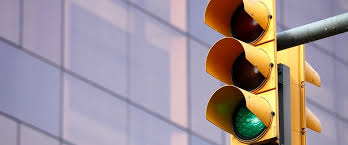Project Objectives:
- Identify areas where traffic accidents have a high occurrence
- Understand the placement and effectiveness of different traffic lights
- Understanding the accident occurrence rate for each traffic light type
Identifying areas where traffic accidents had a high occurrence
The Kernal Density Analysis shows where traffic accident occurrences are high but weighing the “crash count” heavier than another field. Darker the purple, the higher the density and traffic accident occurrence. From the maps…
- Pedestrian Actuated intersection accidents were high when located in commercial areas.
- Semi Actuated intersection accidents were high around Cambie and Broadway.
- Fully Actuated intersection accidents were high along intersection that was major and slightly less busy.
- Fixed Time intersection accidents were high in downtown where there was also a high density of these traffic lights.
A pattern with all the traffic signals is that accidents happen along major roads and commercial activity. This may be attributed to the higher possibility of accidents due to the higher flow of traffic and the presence of pedestrian crossings which may distract them from other traffic signals or other vehicles. There are many things drivers must pay attention to in the visual fields when entering an intersection and the presence of pedestrians and pedestrian crossing may just be the thing that diverts their attention causing an accident.
Understanding the placement and effectiveness of different traffic lights
Looking at the distribution of each type of traffic light, there are some distinct patterns and inferences to be made. Starting with the Pedestrian Actuated Signals, there is a relatively even distribution across the city with higher densities in parts of downtown, Broadway and South Granville. As expected with pedestrian actuated signals which are used in areas where major roads intersect with smaller roads and have high pedestrian volumes, these signals are found along major roads where there are lots of commercial activity. Other notable spots are Mount Pleasant and south-east Hastings.
Semi Actuated signals used to manage intersections with high traffic and a crossing of low traffic are distributed along major roads. There is a high density of these traffic signals around Cambie and Broadway. This is also a major commercial area where the flow of traffic can change throughout the day and congestion needs to be avoided. It is also found along major roads such as Cambie, South Granville, and Southeast Marine Drive.
Fully Actuated signals are found the least in Metro Vancouver. They are sparsely distributed around Metro Vancouver with none in the downtown region but increasing more on the East side of Metro Vancouver. These signals are used to manage intersections with a high flow and slightly slower flow of traffic. It is unique in the way that traffic lights change depending on the flow of traffic. Since both intersecting roads may have high and low flows, these are placed at major semi-major intersections such as 41st and Oak or 33rd and Knight. These are intersections of major roads with slightly less busy roads.
Fixed Time signals notably have an extremely high density in the downtown region. As this is a traffic signal used to manage high volumes of traffic and pedestrians throughout the day, it is expected to be used at intersections downtown where there is lots of traffic and pedestrian activity due to commercial and business activities. The pre-fixed times allow for traffic and pedestrian release at consistent intervals to avoid congestion. These traffic signals can also be found around Metro Vancouver along major roads as well.
Understanding the accident occurrence rate for each traffic type
There is variability in the number of crashes at each intersection. The histograms provide information on the distribution of crash occurrence rates. Pedestrian Actuated Signals show a large distribution range relative to other signals. With most intersections showing roughly 1crash but up to roughly 29 crashes is possible, it has an average of 4 crashes at intersections. Semi-Actuated intersections show that 1 crash at an intersection is the most common but up to roughly 52 crashes is possible. It has an average of 7 crashes at intersections. Fully Actuated intersections have a smaller distribution range relative to others, with roughly 26 crashes at intersections to be the most common and up to 130 crashes possible. Notably, the mean and median values are very similar, indicating that it is more or less evenly distributed. A high 31 accidents are the average at these intersections. Lastly, Fixed Timed signals show one accident per intersection to be the most common but accident occurrence can range up to 88 times.

https://www.greatersudbury.ca/live/transportation-parking-and-roads/traffic-management-and-road-safety/traffic-signals/